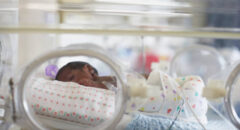 Many risks and complications can be associated with early delivery. Often initial discussions between parents and the NICU doctor focus on issues that preemies face early on including lung disease, infection, slow feeding and risk of bleeding in the brain. Another organ system that may not be fully developed when a preemie is born is the eye. Did you know that your preemie could be at risk to develop eye disease or vision problems?
Many risks and complications can be associated with early delivery. Often initial discussions between parents and the NICU doctor focus on issues that preemies face early on including lung disease, infection, slow feeding and risk of bleeding in the brain. Another organ system that may not be fully developed when a preemie is born is the eye. Did you know that your preemie could be at risk to develop eye disease or vision problems?
Understanding Eye Development
Development of the eyes in babies begins at about 5-6 weeks of pregnancy. During this time different tissue layers of the eyes are formed. These tissue layers give rise to different structures that make up the eye including the retina, lens and cornea. Eye development then progresses rapidly in the last 12 weeks before delivery.
When a baby is born early sometimes the blood vessels that supply the retina, an area at the back of the eye, are not fully formed. The retina receives light and is responsible for signaling between the eye and the brain. Complications from prematurity such as low oxygen levels, anemia, unstable blood pressure and infection can lead to abnormal growth of the blood vessels called retinopathy of prematurity (ROP).
Approximately 380,000 babies are born premature in the United States each year. About 14,000-16,000 preemies will develop ROP with 400-600 of these babies becoming legally blind.
Stages of ROP
There are 5 stages of ROP and stage 1 or 2 indicates mild to moderate disease while 3-5 is more severe. Stages 1-2 typically resolve as the baby grows and the eyes develop. Stage 3 may resolve but sometimes requires intervention depending on the severity. ROP may be treated with laser therapy which burns or cryotherapy which freezes the sides of the retina as well as injection of medicine into the eye. The goal of these treatments is to the stop the growth of the abnormal blood vessels.
If ROP progresses there is greater risk for significant vision loss and even blindness. This is because abnormal blood vessels leak and bleed which can cause scarring and may result in pulling the retina away from the wall of the eye. This involves stages 4 and 5 and causes partial or complete separation known as retinal detachment. Treatment options for these injuries require surgical procedures and tend to have poor outcomes for future vision.
While this seems very scary it is good to know that 90% of preemies with ROP will have milder disease meaning only 10% will be severely affected. As researchers continue to study this disease, hopefully in the future more interventions will be available to prevent significant vision loss and blindness in these preemies.
Protect Your Preemie's Eyes
It is important to note that not all preemies will get ROP. The preemies at risk are those born at less than 30 weeks of pregnancy or less than 1500 grams (3 lbs) at birth. There are no outward signs that a preemie’s eyes have been affected so high risk babies receive eye exams at about 4 to 6 weeks of life.
The eye doctor or ophthalmologist will perform these eye exams and will check a preemie’s eyes routinely until they are fully mature. Even after the eyes are fully mature preemies will still need to follow up in 1 year. This is because preemies with ROP are at risk for vision problems such as myopia (nearsightedness), strabismus (cross eyes), amblyopia (lazy eyes) and glaucoma.
 Dr. Launice is a Board certified Pediatrician trained in the specialty of Neonatology whose passion is caring for sick babies and helping Moms transition to life in the NICU with a preemie. She is an author, speaker and social media expert.
Dr. Launice is a Board certified Pediatrician trained in the specialty of Neonatology whose passion is caring for sick babies and helping Moms transition to life in the NICU with a preemie. She is an author, speaker and social media expert.
Learn more about Dr. Launice at www.drlaunicemd.com and by following her on Facebook, Instagram, Twitter and Youtube @DrLauniceMD.








